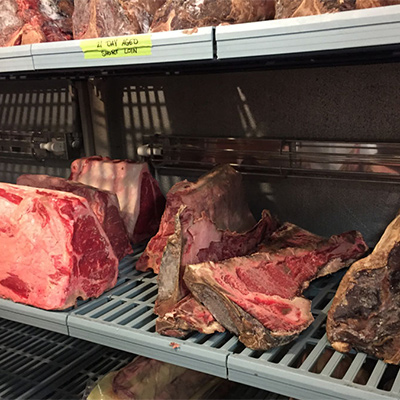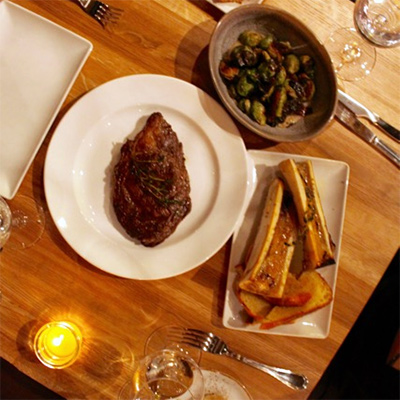Blood and Gingham: Urban Farmer Reviewed

Photo by Arthur Etchells
By my own estimate, I consumed 13 billion calories at Urban Farmer the last time I was there. Maybe 13 and a half. I’m not very good at math, but I’m still pretty sure I’m right. And if I’m not, it surely felt that way. So much red meat. So much starch. So much cornbread, hot Parker rolls with melting butter, crumb-topped creamed spinach spooned from a cast iron bowl. So many sea creatures. And all of it—all of it—was so good.
There were problems, sure. The service varied between charmingly bumbling and infuriatingly incompetent. The bathrooms looked, from the outside, like you were entering through a giant shipping crate (which was at least in keeping with the faux-homespun style of the place) and, on the inside, like some kind of throwback to black marble Rat Pack Vegas, missing only the elderly man offering breath mints and Brylcreem (which was not at all). And the dissonance between the foie gras and the gingham—between the rustic Amish barn-raising decor at this third Urban Farmer steakhouse from Sage Restaurant Group and the ultimate price tag, which ran to more than a hundred dollars a head—was disturbing. It creates an all-hat-and-no-cattle kind of cowboy situation. Like some soft-handed politician throwing on a new-off-the-rack Carhartt jacket and a pair of stack-heel boots that have never touched mud and trying to prove his down-home bona fides by eating fried chicken with a fork and knife.
But the food? Man … remember a few weeks ago (during the review of LP Steak at the Valley Forge Casino) when I said that my major problem with steakhouses was that they’re the dullest of all possible kinds of restaurants? A culinary monoculture where everything depends on the ability of a few glorified burger-flippers to get the grill marks straight on my rib eye?
Yeah, well I was wrong. Not completely, but a little bit, so now I’m backpedaling.
A steakhouse can be the dullest kind of restaurant. It can exist for decades without ever challenging itself, its model, or the conventional wisdom of what a steakhouse is supposed to be, and people will love it for its commitment to traditionalism and the lure of some fantasy of long-gone power dining. All a common steakhouse has to do is grill the meat, sharpen the knives, get the olive into the martini, and hang on long enough that people start calling it “venerable” (*ahem* the Palm … ).
But Urban Farmer isn’t a common steakhouse. It somehow manages to tap-dance through a minefield of potentially murderous conceptual failures and pull off a very complicated trick by going modern and old-fashioned at the same time. It’s bright and airy (as opposed to dim and cloistered); it eschews paintings of horses in favor of black-and-white abstracts and things made out of barrel staves. It doesn’t have a shrimp cocktail on the menu or piping bags full of mashed potatoes waiting in the back, but it has enough jars of pickled vegetables racked up to be featured in a Portlandia sketch. The farmer’s-daughter costumes on the female servers are bullshit (I’m surprised some manager doesn’t paint freckles on their noses every night before service), and the whole rusticated country-mouse shtick is a blatant bit of anti-class positioning. But the kitchen? Dammit, I love those guys. And for precisely two reasons.
- They know how to cook the hell out of a steak.
- Someone in the organization found a way to make those steaks interesting again—by treating them like charcuterie.

Urban Farmer aging room | Photo by Arthur Etchells
At Urban Farmer, you have a choice between three different tenderloins—an eight-ounce Piedmontese from Montana, grain-finished and buttery; another from Red Top Farm (100 percent grass-fed); and a third from local purveyor 1885 Beef. There are five different New York cuts (a 14-ounce from Red Top, another from Creekstone Prime out of Kansas, finished on corn, and two from 1855—a 21-day dry-aged piece and another that’s been napping for 42 days—plus a 12-ounce cut of 7X Wagyu, corn-fed in Colorado) and three different rib eyes and butcher cuts chosen in-house. And then there’s a second, special menu that’s just what came in fresh from the purveyors—odd cuts and limited-availability specials that can be awesome or pedestrian or somewhere in between.
This alone—this idea of facing the steaks off by producer rather than by cut or weight (and not making the classic steakhouse assumptions that all New Yorks are the same regardless of their provenance, and that customers don’t care about the differences between grass-fed and corn-finished)—would have been enough to make me like the place. This, along with the kitchen’s ability to not blow it at the grill or on the pass, would have been enough for me to say, Yes, go here, please. Save up for it because it ain’t cheap, but it is—as is so rarely the case with steakhouses—worth it if you care at all about the finer pleasures of the shameless carnivore’s lifestyle. And I would have told you that despite the fact that one night a server topped up my gin and tonic from the water pitcher (twice!) and on another a different server used at least two completely made-up words while describing the nightly offering of oysters (because there’s no such place as “Whalefleet,” and “kinda brine-ish” isn’t an acceptable descriptor under any circumstances).
But what Urban Farmer did that really struck me was to offer these steaks in this fashion not just as a gimmick, not as some hollow sop to this moment of eco-consciousness we find ourselves in (my steak can be just as local and as responsibly raised as your kale), but as a foundational tenet of the restaurant itself. It was built (in the former home of Fountain, at the former Four Seasons, which is now called the Logan) to be able to do just this. Everything about the place is about choices—about weighing this against that, comparing one thing to another. They have an in-house cheesemonger who pushes a cart around the dining room, offering samples and a brief education. The massive kitchen is full of experts on one thing or another who are available to give their opinions on this producer or that one, this cut or that. At the bar on a busy night, one of the bartenders crooned Tom Petty songs to me across the rail (she sold “American Girl” better than she did “Free Fallin’,” but I liked both) while I eavesdropped on a knot of staff and management heatedly discussing the available seafood offerings for the night, where they’d come from, how to describe them most accurately (note: not as “kinda brine-ish” or from “Whalefleet”). And if you’ve got the time, the money and the available digestive real estate, the menu even offers a steak tasting—three six-ounce New York cuts from three different producers, aged and not—that is just about the coolest way I’ve ever seen to experience the best a steakhouse has to offer.

Table at Urban Farmer | Photo by Emily Teel
And look, I would tell you that the 21-day dry-aged New York strip from 1855 Beef was the best thing I ate, but that would be slighting the fingerling potato tart with cheddar, chives and thick-cut ribbons of bacon, served pie-style and perfect inside its own mini cast iron skillet. And If I told you the tart was the best thing on the menu, I’d feel guilty about not naming the rib eye from Red Top Farm in Missouri, which was salty, sure (no one will ever accuse Urban Farmer’s kitchen of under-seasoning the meat), but so tender at medium rare that it almost fell to pieces when just shown the gleaming blade of one of Urban Farmer’s custom Spanish-steel steak knives. In place of a shrimp cocktail, the kitchen butterflies three monster shrimp and lays them flat across a bed of pickled cucumber and chopped tomato, dressed with a tomato vinaigrette and striped with hot sauce. The winter squash soup is poured tableside, the creamy broth pooling around an island of stacked hushpuppies hot from the fryer, and a foie gras bread pudding that’s normally served alongside the duck breast managed, in a spread of plates where everything was excellent, to stand out for its rich, silky texture and luxurious flavor. When I asked if the kitchen could give it to me as a side (without the duck, the mushrooms, the Armagnac cherries), my waiter went to negotiate on my behalf, got it for me, and charged me less for it than for a side of Castle Valley popcorn grits.
That still wasn’t enough to make me forgive the ruination of two perfectly good gin and tonics, but it was a rare moment of competent, considerate service on the floor, and I’ll take what I can get.
3 stars – Come from anywhere in the city.
Urban Farmer [Foobooz]


